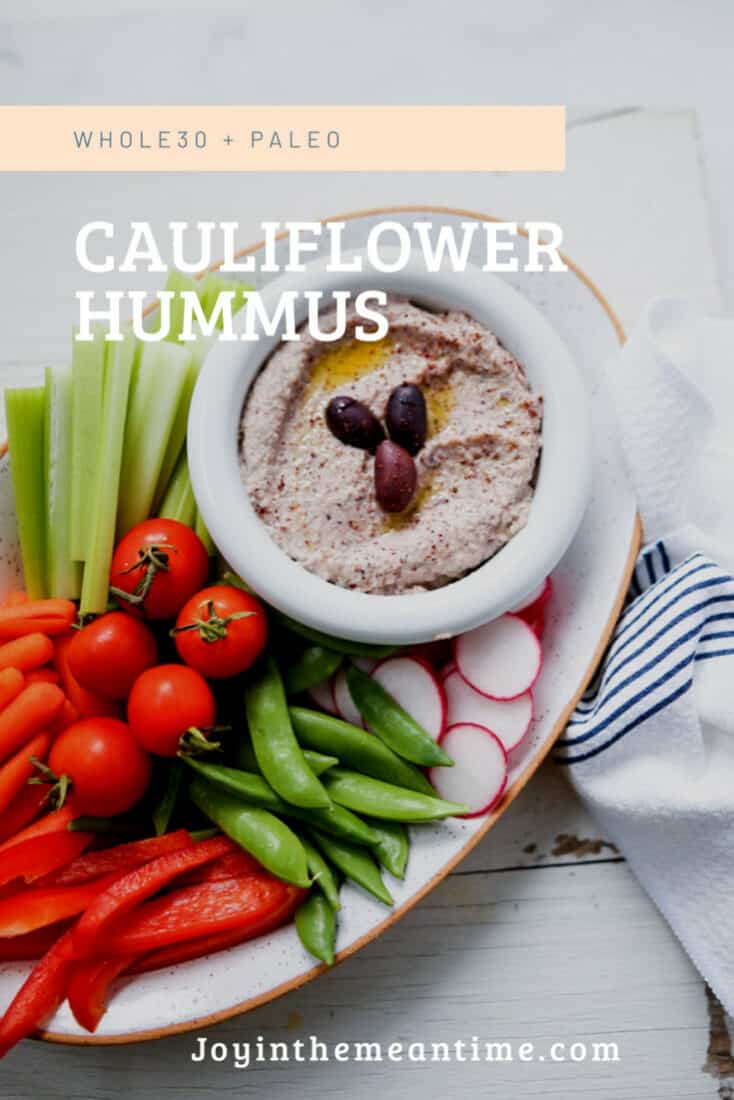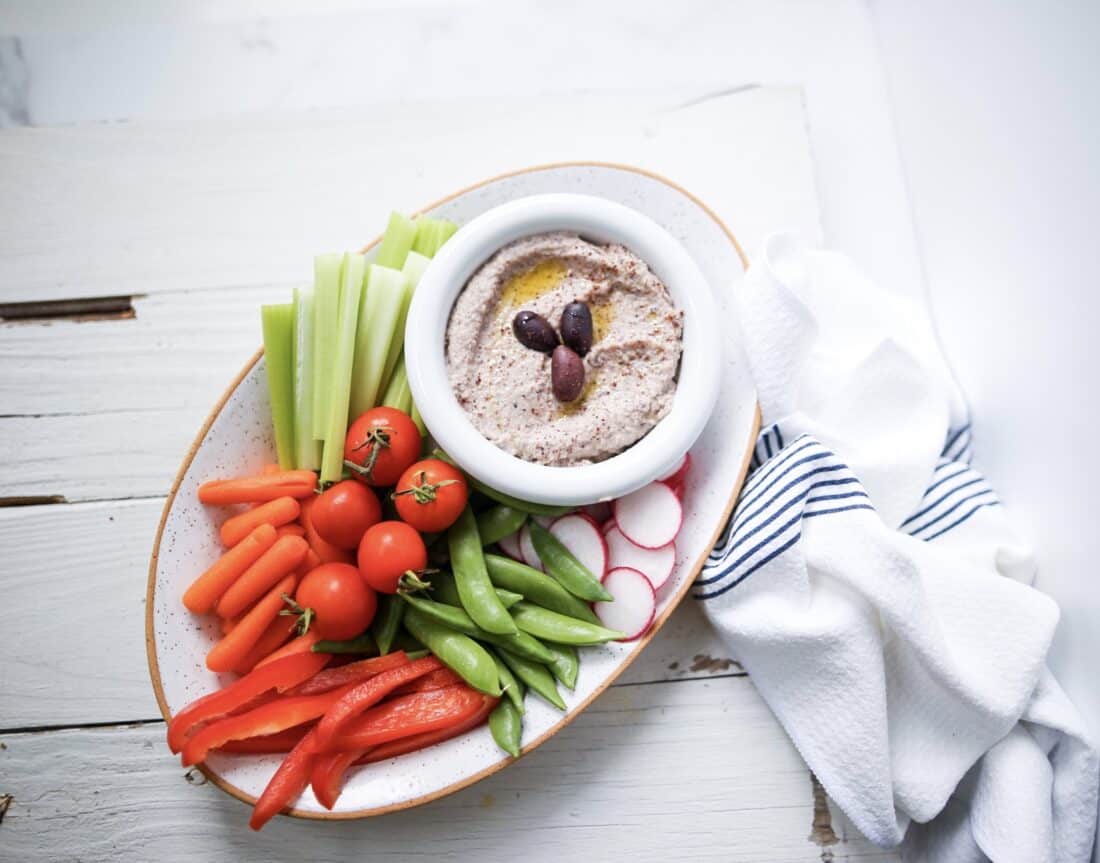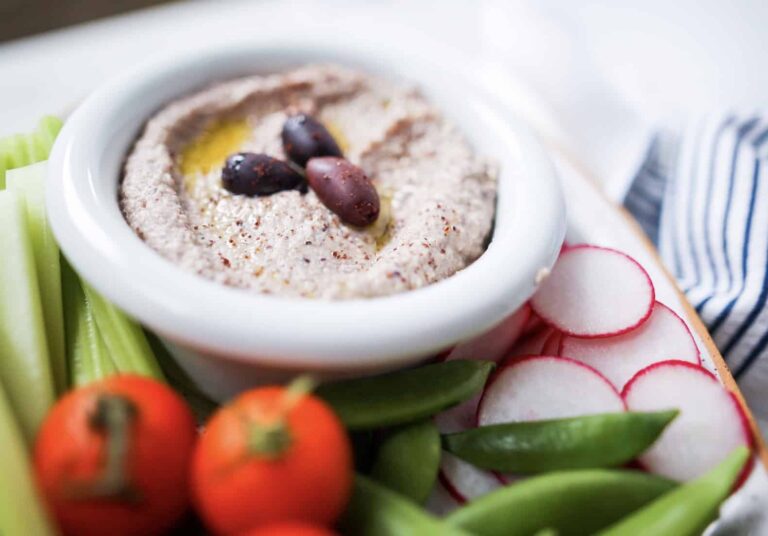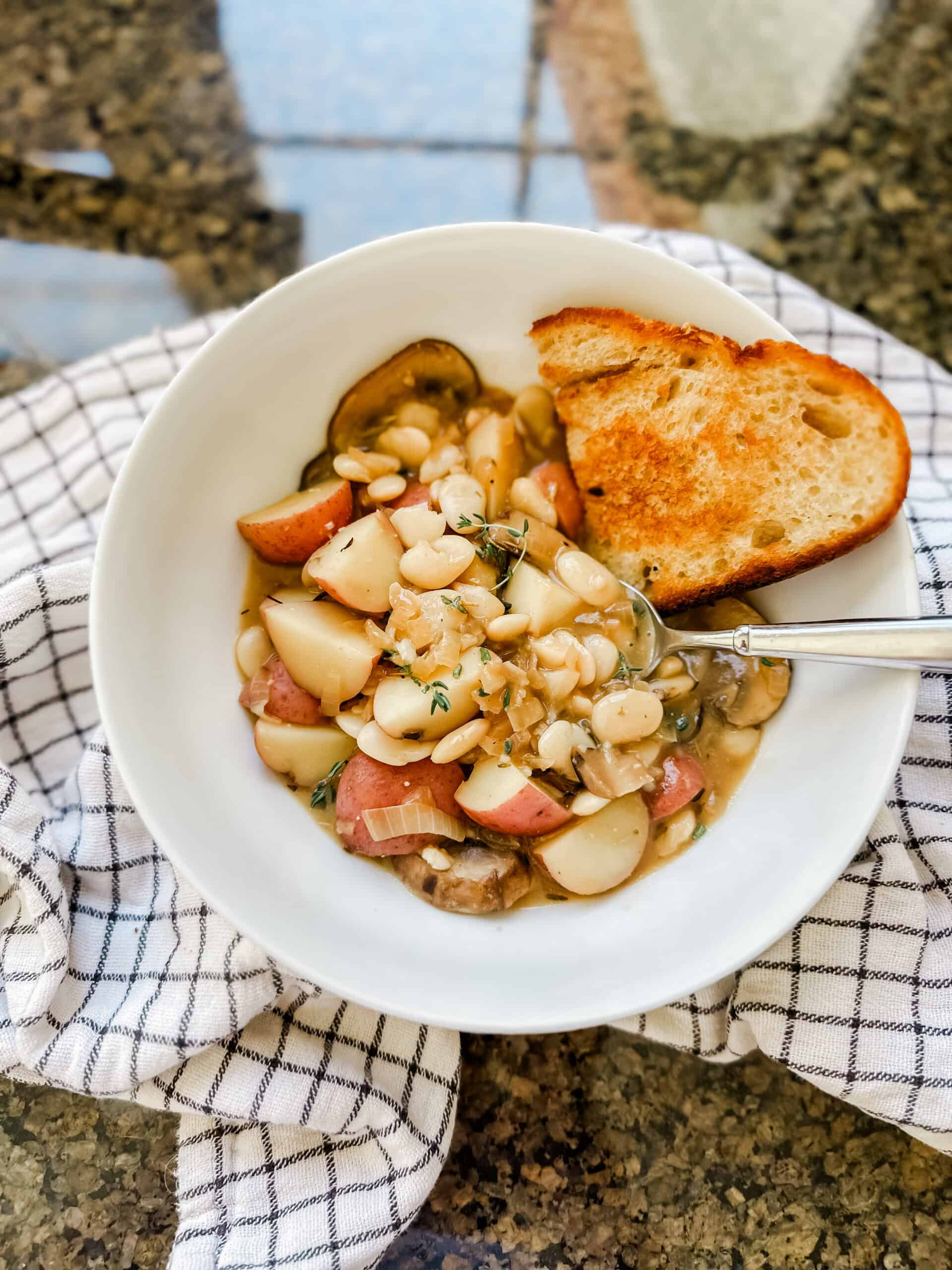Made with fiber-rich vegetables and healthy fats, this Cauliflower Hummus is a low carb version of your favorite hummus! Make it ahead of time for a healthy dip, easy sandwich spread, delicious salad topper, and more.
While I love following a Paleo and Whole30 diet, from time to time there are a few foods I miss such as hummus. There’s just something about the creamy texture and rich taste I can’t get enough of. So, to bring one of my favorite foods back into my life without deviating from my diet which I know will end up making me feel bloated and lethargic, I set out to make a Paleo and Whole30 friendly hummus dip!
While the ingredients are fairly different from those you would see in traditional hummus, I think I nailed this recipe. Not to toot my own horn or anything, but the texture is spot on. Plus, it’s loaded with super nutritious ingredients and fiber to not only cure your hummus craving but also keep you full throughout the day. It’s low carb, full of flavor, and completely delicious.
Recently, I served this dip as an afternoon snack for my boys, and they loved it! They were a little skeptical at first, but once they tried it, they were hooked. In my quest to serve healthy recipes to my family I’ve created several alternatives to dips and sauces such as this Creamy Jalapenoño Cilantro Sauce or my Shallot Dijon Vinaigrette. However, while they’re all great, this Cauliflower Hummus recipe might be my favorite to date. After all, there’s not much it doesn’t go well with!
You’re going to be just as amazed as I was when you see what goes into this “hummus” dip and just how easy it is to make.

Ingredients Needed to Make Cauliflower Hummus
To make this Cauliflower Hummus recipe, you’re going to need a handful of easily found items including:
- Cauliflower – For easier blending, use cauliflower rice.
- Tahini – Tahini is made from sesame seeds and full of healthy fats to add a creamy texture and tons of flavor to this recipe.
- Garlic – Using fresh, minced garlic adds more flavor than a powdered or dehydrated version.
- Extra Virgin Olive Oil – I do not recommend substituting the olive oil for an alternative as it may overpower the Cauliflower Hummus.
- Kalamata Olives – Feel free to use any other olives you prefer.
- Sumac – If you can’t find sumac, feel free to substitute it with paprika.
- Lemon Juice – Use the juice from a fresh lemon, or feel free to use the bottled variety instead.
- Salt & Pepper – Season this recipe to taste, but remember it is already full of flavor.
Health Benefits of Cauliflower
Traditional hummus is made with chickpeas, and while super good for you, they’re also fairly high in carbs. Therefore, I wanted to find something to replace them without losing all the nutritional benefits found in hummus. Through several rounds of experiments, I finally decided on using cauliflower instead. Mild in flavor, this veggie was able to absorb and complement the other ingredients without becoming overpowering. Plus, when steamed, it can easily be broken down to a soft, hummus-like texture. Even better, cauliflower is packed full of nutrients including:
- Choline – Choline is an essential nutrient that helps with fat transport and metabolism in your body, nervous system maintenance, and more.
- Vitamin C – Vitamin C can help reduce high blood pressure, lower the risk of heart disease, and boost your immunity.
- Vitamin K – Vitamin K can help improve your bone health, cognitive health, and heart health.
- Folate – Folate helps your body make healthy red blood cells and is very important to obtain during growing periods such as in adolescence and during pregnancy.
If you’re interested in learning more about the incredible health benefits of cauliflower and why you should add it to your diet, be sure to take a look at this article.

How to Make Paleo Cauliflower Hummus
This Cauliflower Hummus is one of the easiest recipes to make….like, ever. Seriously! In just 3 easy steps, you’re finished and on your way to snacking.
First, clean and chop the cauliflower into florets. Then, steam or boil the pieces until they are fork-tender. Once cooked, drain the extra water.
Place the cauliflower and remaining ingredients except for the radishes into a food processor or blender, and pulse (or blend) until a smooth consistency is reached.
To finish, add salt and pepper to taste and garnish with a dash of sumac and a drizzle of olive oil!
How Long Does Homemade Cauliflower Hummus Last?
When stored in an airtight container in the fridge, this hummus dip will last between 3-5 days. However, if you want to expand its shelf life, you can keep it stored in the freezer anywhere between 6-8 months.
Serving Suggestions for Cauliflower Hummus
My favorite way to eat this Cauliflower Hummus is as a dip with raw veggies such as carrots, celery, and peppers. However, there are endless ways to use this recipe. Your only limit is your imagination!
For example, we have used this for everything as simple as a quick snack with pita chips and crackers, to a yummy salad dressing alternative, and even a base for a flatbread pizza. However, it’s also great spread on sandwiches, mixed in pasta, and cucumber roll ups.
If you come up with any unique ways to use this recipe, I’d love it if you let me know in the comments below! I’m always looking for easy ways to make mealtimes fun.
Of course, if you make and love this Cauliflower Hummus or any of my other recipes, please tag me on Instagram! I’d love to see your creations, connect, and share your page. I hope you love this recipe as much as I do. Stay tuned for new recipes, easy meal plans, decoration tips, and more every week!
In the meantime, enjoy!
Karin

Ingredients
- 1 lb cauliflower
- 1/4 cup tahini
- 2 cloves garlic
- 1/2 cup olive oil extra virgin
- 1/2 cup kalmata olives pitted
- 1 tsp sumac you can sub paprika
- 1 tsp cumin
- 1 lemon juiced
- light drizzle olive oil for garnish
- salt and pepper to taste
Instructions
- Clean and chop cauliflower into florets. Steam or boil until fork tender; drain
- Place cauliflower and remaining ingredients (minus the garnishes) into a food processor or blender, and pulse until it is a smooth consistency
- Salt and pepper to taste, garnish with a sprinkle of sumac, drizzle olive oil, and serve with desired sides
P.S. This page may contain affiliate links. Of course, you’re not obligated to use them, but I appreciate the love if you do!



